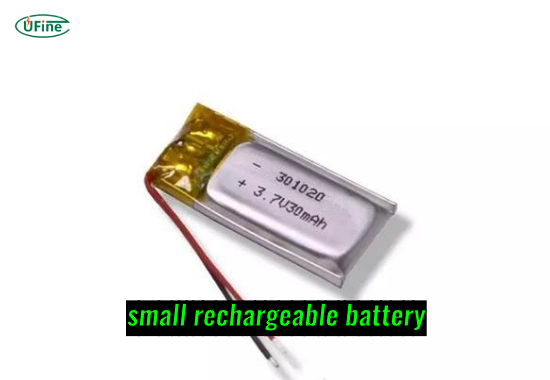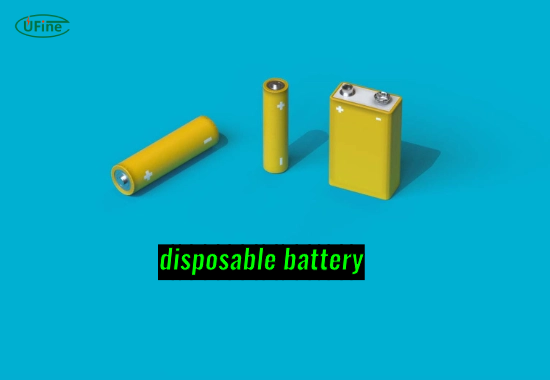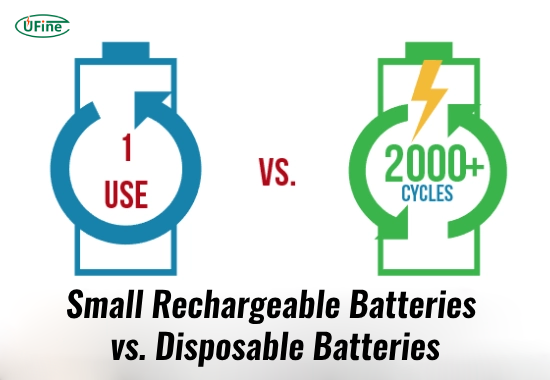In today’s world, where gadgets and electronics dominate our daily lives, batteries play an indispensable role. Batteries are everywhere, from powering remote controls and flashlights to fueling high-tech devices. But when it comes to choosing between small rechargeable batteries and disposable batteries, the decision can be challenging. Which is better regarding cost, efficiency, environmental impact, and convenience? This article will dive deep into the pros and cons of small rechargeable and disposable batteries, helping you make an informed choice.
Part 1. What are small rechargeable batteries?
Small rechargeable batteries are energy storage solutions designed for repeated use. Unlike single-use disposable batteries, people can charge rechargeable batteries and reuse them hundreds or thousands of times. Common types of rechargeable batteries include lithium-ion (Li-ion), nickel-metal hydride (NiMH), and nickel-cadmium (NiCd) batteries.
Electronics such as smartphones, cameras, toys, and power tools are widely used. Their ability to retain energy after charging makes them a sustainable and cost-effective solution for long-term use. But how do they compare to their disposable counterparts? Let’s explore.
Part 2. What are disposable batteries?
Disposable batteries, also known as primary batteries, are single-use batteries that cannot be recharged. Once their energy is depleted, they must be discarded. Common types include alkaline, zinc-carbon, and lithium disposable batteries.
Due to their convenience and affordability, disposable batteries are commonly used in low-power devices like remote controls, wall clocks, and smoke detectors. However, their one-time-use nature raises questions about sustainability and long-term cost-effectiveness.
Part 3. What are the pros of small rechargeable batteries?
1. Long-term cost savings
Although rechargeable batteries may have a higher upfront cost, they save money in the long run. Since they can be recharged hundreds or even thousands of times, you don’t need to buy replacements frequently.
2. Eco-friendly and sustainable
Rechargeable batteries significantly reduce waste compared to disposable batteries. Instead of discarding batteries after every use, you can recharge and reuse them for years, lowering your environmental footprint. Many modern rechargeable batteries are also made with materials that are less harmful to the environment.
3. High energy capacity
Rechargeable batteries often have a higher energy density than disposable ones, so they can power devices for extended periods before recharging
4. Versatility
These batteries are compatible with various devices, from household gadgets to high-power tools. Many rechargeable batteries now come in standard sizes like AA or AAA, making them a perfect replacement for disposable options.
5. Technology advancements
Modern rechargeable batteries, such as lithium-ion batteries, offer features like faster charging times and longer lifespans, making them more convenient and reliable.
Part 4. What are the cons of small rechargeable batteries?
1. Higher upfront cost
One of the most significant drawbacks of rechargeable batteries is their initial cost, which is more expensive than that of disposable batteries.
2. Limited lifespan
Rechargeable batteries degrade over time. After a certain number of charge cycles, their ability to hold a charge diminishes, eventually requiring replacement.
3. Charging time
Rechargeable batteries require time to recharge. This can be inconvenient if you need immediate power and don’t have a charged battery.
4. Shelf life
When not in use, rechargeable batteries tend to lose charge over time (self-discharge). This makes them less ideal for devices that require long-term storage without frequent use, such as emergency flashlights.
Part 5. What are the pros of disposable batteries?
1. Convenience
Disposable batteries are ready to use right out of the package. You don’t need to worry about charging them, making them ideal for situations where you need quick, reliable power.
2. Low upfront cost
Disposable batteries are inexpensive, making them accessible and affordable for short-term or infrequent use.
3. Long shelf life
Unlike rechargeable batteries, disposable batteries have a much longer shelf life. They retain their charge for years, making them suitable for devices like smoke detectors and emergency equipment.
4. Availability
Disposable batteries are widely available and come in various types and sizes to meet the demands of different devices.
Part 6. What are the cons of disposable batteries?
1. Environmental impact
Disposable batteries contribute significantly to environmental waste. Since they are single-use, millions of batteries end up in landfills each year, where they can leak harmful chemicals into the soil and water.
2. Long-term cost
Disposable batteries are more expensive in the long run. Constantly replacing dead batteries can quickly add up, especially for devices that consume much power.
3. Lower energy capacity
Disposable batteries generally don’t last as long as rechargeable ones. For high-drain devices, their energy is depleted much faster, necessitating frequent replacements.
4. Limited performance in high-drain devices
Devices that require a lot of energy, such as cameras or gaming controllers, often drain disposable batteries quickly, reducing their practicality for such applications.
Part 7. Which battery is better for the environment?
Rechargeable batteries have a clear advantage when it comes to environmental impact. By reducing the number of batteries discarded in landfills, they help minimize hazardous waste. While rechargeable batteries still require proper disposal at the end of their lifespan, their overall environmental footprint is much smaller than disposable batteries.
Part 8. Which battery is more cost-effective?
If you’re looking at the long-term cost, rechargeable batteries win. Although they may cost more initially, their ability to be reused hundreds of times makes them a much more economical choice. Disposable batteries, however, are more suited for short-term or occasional use.
Part 9. FAQs
-
Are rechargeable batteries worth it?
Yes, rechargeable batteries are worth it for devices you use frequently. They save money in the long run, reduce waste, and offer better performance for high-drain devices. -
How long do rechargeable batteries last?
The lifespan of rechargeable batteries depends on their type and usage. Lithium-ion batteries can typically be recharged 300-500 times, while NiMH batteries can last up to 1000 cycles. -
Can disposable batteries be recycled?
Many disposable batteries can be recycled, but it depends on the type and local recycling facilities. Always check recycling guidelines in your area to ensure proper disposal. -
Do rechargeable batteries lose capacity over time?
Rechargeable batteries lose capacity over time due to repeated charge and discharge cycles. This is a normal part of their lifecycle. -
Which type of battery is best for high-drain devices?
Rechargeable batteries, particularly lithium-ion or NiMH batteries, are better suited for high-drain devices because of their higher energy capacity and ability to handle frequent use.
Related Tags:
More Articles

How to Choose the Best Jigsaw Tool Battery for Long-Lasting Power
Discover the top jigsaw tool batteries for power & runtime. Compare Li-ion vs. NiCd, top brands, and tips to extend battery life. Read now
The Logistics of Bulk Battery Orders: Shipping, Storage, and Hazmat Compliance
Learn how to safely manage bulk battery orders with tips on shipping, storage, and hazmat compliance for smarter, safer logistics.
Microcurrent Facial Device Battery Guide & Tips
Learn all about microcurrent facial device batteries, from types to lifespan, and how to choose a reliable supplier for long-lasting, safe skincare performance.
Power Pack Battery vs. Power Bank: What’s the Difference?
Power pack vs power bank: Learn the key differences, pros, and best uses to choose the right portable power source for your lifestyle.
What Is a Power Pack Battery and How Does It Work?
A power pack battery stores energy for off-grid use, emergencies, or travel. Learn how it works and how to choose the right one for your needs.






